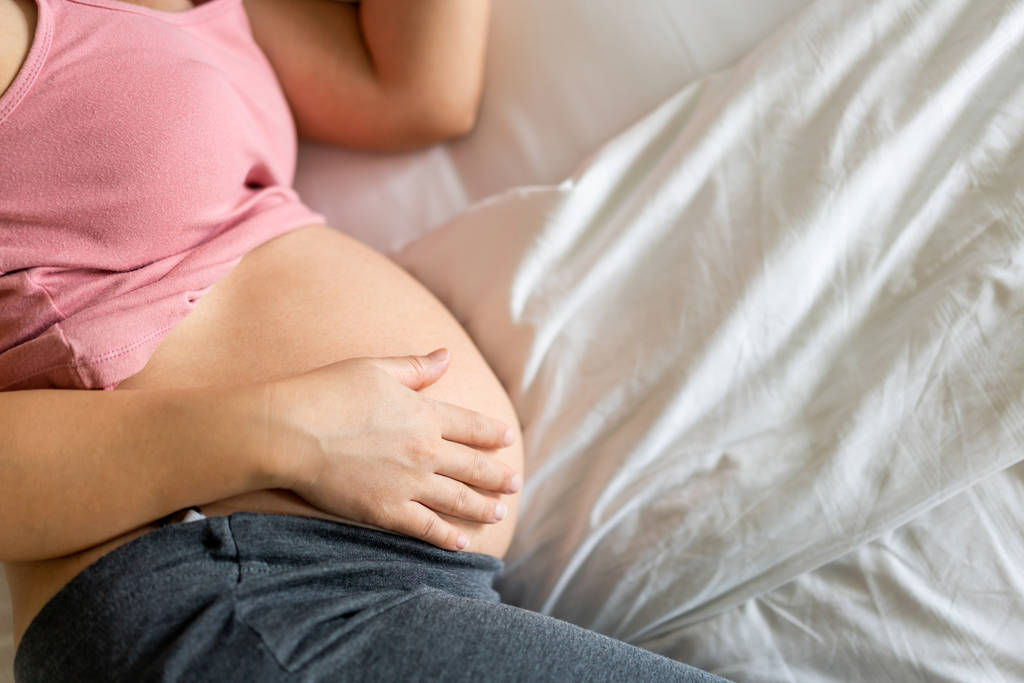Learn effective ways to support your lower back during the first trimester of pregnancy.
How to Support Your Lower Back During the First Trimester
One of the most common complaints during pregnancy is lower back pain. As your body goes through significant changes, it’s essential to provide proper support for your back to alleviate discomfort and maintain overall well-being. In this article, we will explore various strategies to support your lower back during the first trimester, from understanding the changes in your body to incorporating safe exercises and adopting healthy nutrition habits.

Understanding the Changes in Your Body
During pregnancy, your body undergoes incredible transformations. These changes can have a significant impact on your lower back, causing discomfort and pain. It’s important to be aware of how pregnancy affects your back, so you can take necessary steps to support it.
The Impact of Pregnancy on Your Lower Back
Pregnancy places additional strain on your lower back due to the weight gain and the expanding uterus. As your belly grows, your center of gravity shifts forward, placing more pressure on your lower back. This added strain can lead to muscle tension, stiffness, and pain.
Furthermore, the hormonal changes that occur during pregnancy can also contribute to lower back pain. As your body prepares for childbirth, it releases hormones such as relaxin, which increases the flexibility of your ligaments. While this increased flexibility is essential for the birthing process, it can also make your joints and ligaments more susceptible to strain and discomfort.
Additionally, the growth of the baby itself can put pressure on the nerves in your lower back, leading to sciatica. Sciatica is a condition characterized by pain that radiates along the path of the sciatic nerve, which runs from your lower back through your hips and down each leg. This condition can cause sharp, shooting pains, numbness, and tingling sensations in your lower back and legs.
Hormonal Changes and Their Effects on Your Back
During the first trimester, your body experiences hormonal changes to support the growth of your baby. These hormonal shifts, such as increased levels of relaxin, can lead to ligament laxity, making your joints and ligaments more susceptible to strain. This increased flexibility, while beneficial for childbirth, also increases the risk of back pain.
Moreover, the hormonal changes during pregnancy can also affect the discs in your spine. These discs act as shock absorbers between the vertebrae, providing cushioning and support. The hormonal fluctuations can cause these discs to become more pliable, which may lead to a higher risk of herniated discs or bulging discs. These conditions can cause intense back pain, as well as radiating pain, numbness, and weakness in the legs.
It’s worth noting that every woman’s experience with pregnancy-related back pain is unique. Factors such as pre-existing back conditions, posture, and physical activity levels can all influence the severity and frequency of back pain during pregnancy. Therefore, it’s crucial to listen to your body and consult with your healthcare provider for personalized advice and recommendations.
Essential Tips for Lower Back Support
Now that you understand how pregnancy impacts your lower back, let’s explore some essential tips to support it throughout the first trimester.
During pregnancy, the lower back is subjected to increased stress and strain due to the growing weight of the baby and the changes in the body’s center of gravity. This can lead to discomfort and pain in the lower back region. However, with the right techniques and practices, you can alleviate this pain and provide the necessary support to your lower back.
Proper Posture for Pregnancy
Maintaining proper posture is crucial for alleviating lower back pain. Stand tall, with your shoulders relaxed and your spine aligned. Avoid slouching or arching your back excessively. By keeping your spine in a neutral position, you distribute the weight evenly and reduce the strain on your lower back.
Additionally, when sitting, it is important to support your lower back. You can use a small pillow or a lumbar roll to provide additional support for your lower back while seated. This helps maintain the natural curve of your spine and prevents excessive pressure on the lower back.
The Importance of Regular Movement
Engaging in gentle, regular movement can help relieve lower back pain and prevent it from worsening. When you are pregnant, it is essential to stay active while being mindful of your body’s limitations.
One of the best ways to stay active during pregnancy is by taking short walks. Walking not only helps improve blood circulation but also strengthens the muscles in your lower back, abdomen, and legs. It is a low-impact exercise that can be easily incorporated into your daily routine.
In addition to walking, prenatal yoga is another excellent option for maintaining lower back support. Prenatal yoga focuses on gentle stretching, strengthening, and relaxation techniques that specifically target the needs of pregnant women. It helps improve muscle strength and flexibility, reducing the strain on your lower back.
Swimming is also highly recommended during pregnancy. The buoyancy of water provides a supportive environment for your body, relieving the pressure on your lower back. Swimming is a low-impact exercise that allows you to move freely without putting excessive stress on your joints.
Remember to listen to your body and avoid exercises that cause discomfort. If you experience any pain or discomfort while engaging in physical activity, it is important to consult with your healthcare provider.
Safe Exercises for Lower Back Strength

Strengthening your lower back muscles is essential for providing support and preventing pain. Here are some safe exercises you can incorporate into your routine:
When it comes to maintaining a healthy and strong lower back, there are various exercises that can help you achieve your goals. It’s important to choose exercises that are safe and effective, targeting the specific muscles that support your lower back.
Gentle Yoga Poses for Pregnant Women
Prenatal yoga offers numerous benefits, including strengthening the muscles that support your lower back. Some gentle poses you can try include cat-cow stretch, child’s pose, and pelvic tilts. These poses not only help in strengthening your lower back but also promote flexibility and relaxation.
During pregnancy, it’s crucial to prioritize safety and listen to your body. Always ensure you have proper guidance and avoid any poses that strain your back or involve lying flat on your stomach. Consulting a certified prenatal yoga instructor can provide you with the necessary modifications and guidance for a safe and effective practice.
Pilates Moves for Lower Back Support
Pilates exercises can help strengthen your core muscles, including those that support your lower back. Consider incorporating moves such as pelvic floor exercises, side-lying leg lifts, and bird-dog pose into your fitness routine. These exercises target the deep muscles of your core, providing stability and support to your lower back.
When practicing Pilates during pregnancy, it’s important to consult a qualified prenatal fitness instructor to ensure your safety. They can guide you through modifications and variations that are suitable for your changing body. Maintaining proper form and alignment is crucial to avoid any unnecessary strain on your lower back.
Remember, before starting any exercise program during pregnancy, it’s important to consult with your healthcare provider. They can provide personalized recommendations based on your individual needs and medical history.
The Role of Nutrition in Back Health
Proper nutrition plays a crucial role in supporting your overall back health during pregnancy. It is important to understand that the food you consume not only affects your overall well-being but also has a direct impact on the health of your back. By making conscious choices and incorporating certain foods into your diet, you can promote strong bones, muscles, and joints, thus reducing the risk of back pain and discomfort.
Here are some tips for maintaining healthy nutrition:
Foods That Promote Bone and Muscle Health
When it comes to back health, incorporating calcium-rich foods into your diet is essential. Calcium is a mineral that plays a vital role in maintaining strong bones and preventing conditions such as osteoporosis. Some excellent sources of calcium include dairy products like milk, yogurt, and cheese. Additionally, leafy greens such as spinach, kale, and broccoli are also rich in calcium.
In addition to calcium, it is important to include lean proteins in your diet. Proteins are the building blocks of muscles and aid in their development and repair. Opt for lean sources of protein such as chicken, fish, and legumes. These foods not only provide essential nutrients but also help support the overall strength and stability of your back.
While calcium and protein are crucial, it is equally important to consider the role of vitamin D in maintaining back health. Vitamin D helps your body absorb calcium effectively, ensuring that it reaches your bones and supports their strength. Fatty fish like salmon and mackerel, eggs, and fortified dairy products are excellent sources of vitamin D.
Hydration and Its Impact on Your Back
Staying hydrated is vital for maintaining optimal back health. Water plays a crucial role in various bodily functions, including the health of your spinal discs and joints. When you are dehydrated, the discs in your spine may become less pliable, leading to increased stiffness and discomfort.
Make sure to drink plenty of water throughout the day to keep your body hydrated. In addition to water, you can also include hydrating foods in your diet. Watermelon, cucumbers, and oranges are examples of fruits that have high water content and can contribute to your overall hydration levels. By staying properly hydrated, you are providing your spinal discs with the necessary nourishment, thus supporting their health and reducing the risk of back pain.
In conclusion, proper nutrition is essential for maintaining back health during pregnancy. By incorporating calcium-rich foods, lean proteins, and vitamin D sources into your diet, you can promote strong bones and muscles. Additionally, staying hydrated by drinking water and consuming hydrating foods can support the health of your spinal discs and joints. Remember, a well-nourished body is better equipped to handle the physical demands of pregnancy and reduce the likelihood of back pain and discomfort.
Comfortable Sleeping Positions for Lower Back Support
Achieving a comfortable sleeping position can make a significant difference in reducing lower back pain. Consider the following tips for better sleep:

The Best Pregnancy Pillows for Back Support
Investing in a pregnancy pillow can provide great relief for your lower back. These specially designed pillows offer support and proper alignment, making it easier to find a comfortable sleeping position. Look for pillows that provide adequate support for your belly and back, such as U-shaped or C-shaped pillows.
How to Arrange Your Sleeping Space
Ensure that your sleeping environment promotes restful sleep and supports your lower back. Use a supportive mattress and consider placing a small pillow or a rolled-up towel between your knees to alleviate strain on your hips and lower back. Experiment with different sleeping positions, such as sleeping on your side, to find what works best for you.
In conclusion, supporting your lower back during the first trimester is crucial for minimizing discomfort and maintaining overall well-being. By understanding the changes in your body, adopting proper posture, incorporating safe exercises, and following a healthy nutrition plan, you can ensure a more comfortable and enjoyable pregnancy journey. Remember to always consult with your healthcare provider before making any significant changes to your routine, and listen to your body’s needs throughout this transformative period.



